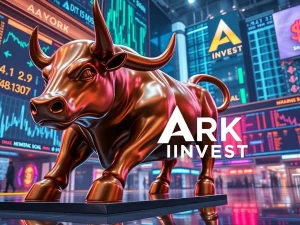Urgent Warning: ‘Failed Altcoins’ Threaten Digital Asset Treasury Clarity, Says David Bailey

The burgeoning world of corporate cryptocurrency holdings faces a critical challenge. David Bailey, CEO of Nakamoto, a prominent digital asset treasury company, recently issued a stark warning. He argues that the inclusion of what he terms ‘failed altcoins’ is significantly muddying the broader narrative surrounding digital asset treasury management. This perspective emerges as companies increasingly explore balance sheet holdings beyond just Bitcoin, sparking a vital debate within the crypto financial sector.
The Digital Asset Treasury Dilemma: Bailey’s Bold Stance
David Bailey, a respected voice in the crypto space, contends that the very concept of a “digital asset treasury company” has become confusing. He highlighted this concern in a recent X post, drawing attention to several issues. “Toxic financing, failed altcoins rebranded as DATs, too many failed companies with no plan or vision. It’s totally muddled the narrative,” Bailey stated emphatically. His remarks underscore a growing tension between those advocating for a Bitcoin-centric approach and those embracing broader altcoin investment.
Bailey’s core argument centers on strategic clarity. He believes many firms are losing sight of the fundamental goal: building and monetizing a robust balance sheet. He emphasizes that success hinges on sound asset management. Companies that execute this poorly risk trading at a discount and eventually being acquired. Bailey’s vision extends to a future where “Bitcoin Banks” become the fiat system’s equivalent, serving as primary Bitcoin financial institutions. This ambitious outlook suggests a clear, focused strategy is paramount for long-term survival and growth in the volatile crypto market.
Why ‘Failed Altcoins’ Cloud the Crypto Balance Sheet Strategy
The term ‘failed altcoins’ carries significant weight in Bailey’s critique. He suggests that some alternative cryptocurrencies lack fundamental utility or sustainable economic models. Including these assets on a crypto balance sheet can introduce unnecessary risk and volatility. Moreover, such investments can obscure the true performance of a treasury, making it difficult to assess genuine value creation.
For instance, a company holding a diverse portfolio might see its overall performance dragged down by underperforming altcoins. This dilution makes it challenging to differentiate between successful strategic moves and speculative gambles. Bailey’s concern is not just about individual asset performance. It extends to the integrity and perceived trustworthiness of the entire digital asset treasury sector. When companies with unclear visions or speculative holdings brand themselves as treasury entities, it can erode confidence across the industry.
Expanding Horizons: Beyond the Traditional Bitcoin Treasury
Despite Bailey’s warnings, many publicly-listed companies are indeed looking beyond Bitcoin. They are moving further down the risk curve to incorporate other crypto assets into their treasuries. This trend signifies an evolving understanding of digital asset management. On August 2, reports emerged that Nasdaq-listed Mill City Ventures III might raise $500 million. This funding aims to support its recently announced Sui treasury strategy, indicating a significant move towards altcoin diversification.
Galaxy Digital’s July 31 report further substantiates this shift. It suggests that narrative-driven theses are compelling firms to expand their treasuries. Ether (ETH), Solana (SOL), XRP (XRP), BNB (BNB), and HyperLiquid (HYPE) are among the cryptocurrencies gaining considerable traction. These assets offer different value propositions compared to Bitcoin. For example, Ether can be staked for annual returns. This feature makes it both a store of value and a potential income source. Currently, approximately 3.14% of Ether’s total supply resides in publicly-listed treasury companies, according to StrategicETHReserve. This growing interest in Ether highlights its dual utility and attractiveness for corporate balance sheets.
The Impact of Altcoin Investment on Bitcoin’s Price Action
The expanding interest in a broader range of crypto assets may also explain Bitcoin’s recent sideways price action. Galaxy Digital CEO Mike Novogratz noted this observation. He believes that treasury companies exploring other coins might be a factor. “Bitcoin’s at a consolidation right now. Partly because you’re seeing a lot of these treasury companies in other coins take their shot,” Novogratz explained. This suggests a reallocation of capital or a broader distribution of new capital inflows across the crypto market.
Historically, Bitcoin often led market rallies, with altcoins following suit. However, a diversified approach by institutional players could alter this dynamic. If significant capital flows into various altcoins, Bitcoin’s dominance might temporarily wane. This does not necessarily signal a decline in Bitcoin’s long-term value. Instead, it reflects a maturing market where other digital assets gain recognition and adoption for their unique functionalities. The interplay between Bitcoin’s foundational role and the innovative potential of altcoins creates a complex market landscape.
Navigating Risks: The Future of Crypto Balance Sheet Management
While altcoins in treasuries face scrutiny, Bitcoin-only treasuries also encounter challenges. Venture capital firm Breed warned that only a select few Bitcoin treasury companies will endure. Many may succumb to a “death spiral” if they trade too close to their net asset value (NAV). This highlights the inherent risks in any single-asset treasury strategy, even with Bitcoin. A lack of operational revenue or an over-reliance on Bitcoin’s price appreciation can lead to financial instability.
Ultimately, a robust digital asset treasury strategy demands careful consideration of several factors:
- Risk Assessment: Thorough evaluation of each asset’s volatility, liquidity, and regulatory standing.
- Strategic Alignment: Ensuring that crypto holdings align with the company’s overall business objectives and risk tolerance.
- Operational Expertise: Developing the internal capabilities to securely manage, account for, and potentially monetize digital assets.
- Long-Term Vision: Moving beyond short-term speculation to build sustainable value through digital asset integration.
The debate ignited by David Bailey underscores a critical juncture for corporate crypto adoption. Companies must weigh the perceived stability of a Bitcoin treasury against the potential diversification benefits and yield opportunities offered by certain altcoins. The path forward requires clarity, strategic foresight, and a deep understanding of the evolving digital asset landscape. Establishing clear policies for altcoin investment will be crucial. This ensures that a company’s crypto balance sheet genuinely reflects its financial strength and strategic direction, rather than being muddled by underperforming assets or speculative ventures. As the market matures, the distinction between a robust treasury and a speculative portfolio will become increasingly vital for investor confidence and long-term success.








